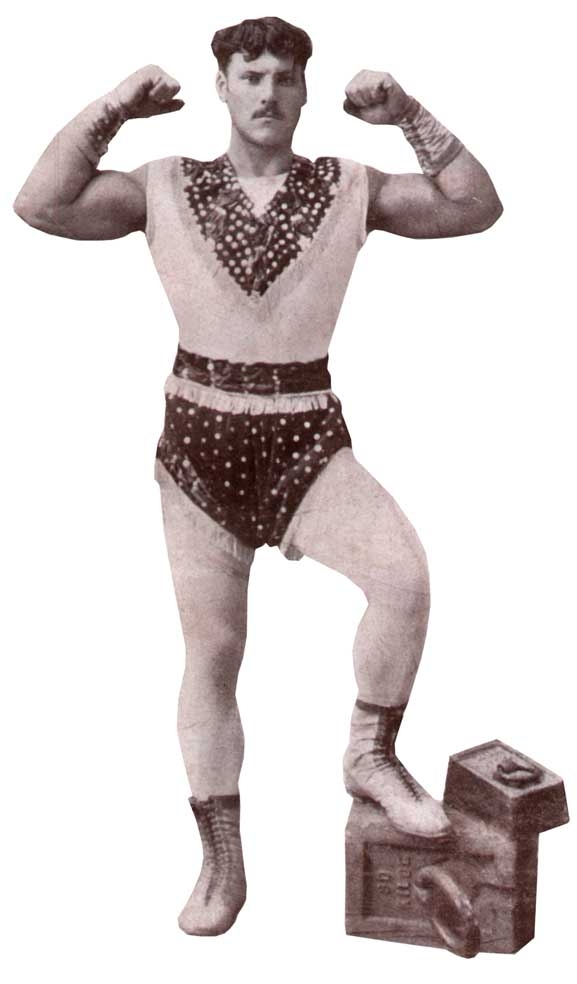
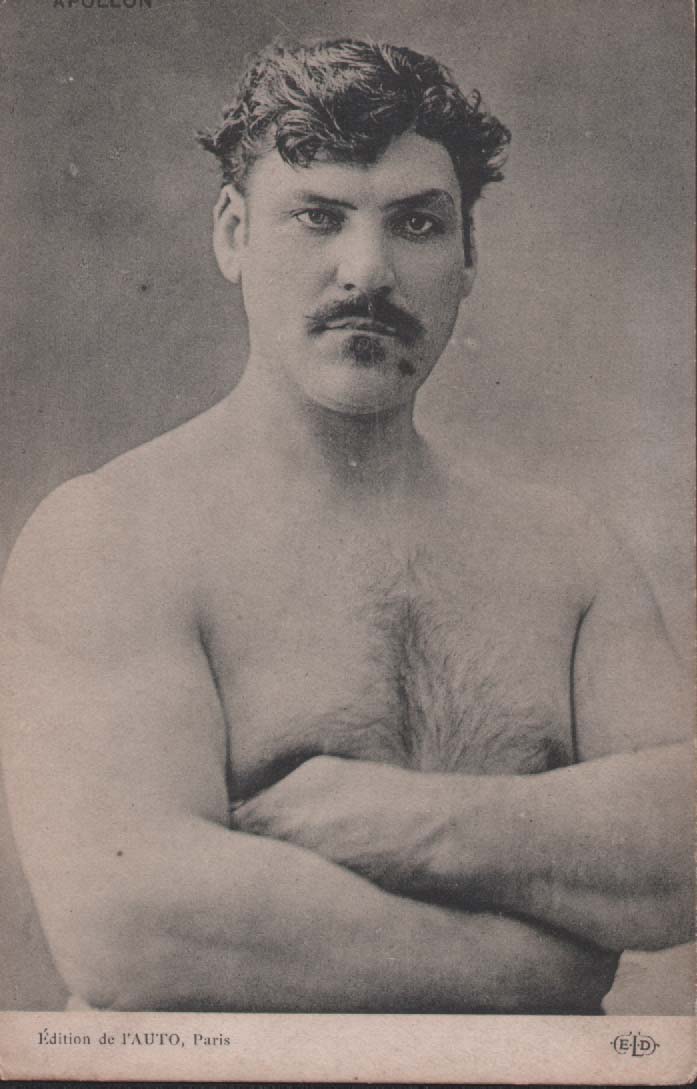
Chronological list of Apollon (Louis Uni) in print
All this information I have accumulated over the years (with the help of Tony Gee and Gherardo Bonini) for a book. I wrote an article on Apollon's visit to Britain and this was published in Iron Grip magazine. Please contact me for further information regarding scanning information for research. If I have the original and it's out of copyright this can be done for a fee. I also have many other strongmen and women in my files. This list will be updated regularly so check back.
I will be adding more information, articles and photos here.
(Updated February 19, 2011)
Born January 28, 1862, in Marsillargues (Herault), France.
p.24. ‘Apollon, The Emperor of Athletes’ by Professor Edmond Desbonnet, Iron Game History, August, 1997.
At 14 years of age (1876), escaped the parents house and joined a travelling Italian circus ‘Caramagne’ at Lunel near Marsillargues, France. During a performance the police nabbed him and returned him to his father.
p.25. ‘Apollon, The Emperor of Athletes’ by Professor Edmond Desbonnet, Iron Game History, August, 1997.
Finally with many misgivings, Louis’s parents allowed him to leave home and work with Felix Bernard and Pietro Dalmasso. He also worked with Henri Pechon and August “the Butcher”.
p.25-26. ‘Apollon, The Emperor of Athletes’ by Professor Edmond Desbonnet, Iron Game History, August, 1997.
At 16 ½ years of age (1878), Mr. Valinot of Toulouse, made a cast of Apollon’s arms.
p.26. ‘Apollon, The Emperor of Athletes’ by Professor Edmond Desbonnet, Iron Game History, August, 1997.
Apollon, real name Louis Uni, born in the Hérault in 1862. In the premises of Lille's club, he snatched one hand 80 kilos. He voiced personally to me that he is capable to keep horizontally at full stretched arm a dumbell, that touched by the hand only, of 36 kilos. 'By force' with two hands kilos 92 [my note, Obizzi with 'by force' intends what modernly was named by the Russian press, with back inclined backward]. It is believed that he jerked with two hands 120 kilos, in fact he was unable to elevate to shoulders a bar belonging to Rasso Trio of 136 kilos. He was never watched in whatsoever club to practice two hands exercises.
List of places Apollon visted.
Jeantien Carnival, Bordeaux, France. p.26.
Folies Bergere, Paris, France. p.26.
Hippodrome, Paris?, France. p.26.
Grand Orient, Rue Cadet, France. p.26.
Trained at the arena of the athlete ‘Paris’. p.26.
Cirque d’Hiver. p.26-27.
Joigneret’s gymnasium on the Rue des Tilleuls in Montmartre, France. p.27.
Aquarium, London. p.27.
Fete de Neuilly, Marseille?, France. p.27.
Lille, France. p.27.
Antwerp, Belgium. p.27.
Brussels, Belgium where he subdued several lions (!) at the Pezon Mengerie. p.27.
[Had some training on taming tigers from his wife Josephine Pezon, and was in the cage after as a featured animal trainer, attired in the style of that profession.
p.145-146. Anvils, Horseshoes and Cannons, Volume 1 – Leo Gaudreau. 1975.]
Beat Karl Abs at Wulff’s establishment in Brussels, Belgium. p.27.
Louvain. p.27.
Liege, Belgium where he beat the strongest man in the city Lhonneux. p.27.
Tour with Paul Pons across Europe. p.27.
Feats of strength done whilst visiting ‘Paris’, ‘The Boat man’. Sandow was there and first to congratulate Apollon. p.40.
Apollon deadlifted a 500 lb dumbbell with (church bell shaped weights) one handed. John Grunn had lifted it easily with two hands. At 48, Faubourg Poissoniere, France. p.41.
Apollon’s lifting of Briancon Pastilles [I’m very dubious of this feat of strength. D.H.] p.40-41.
‘Apollon, The Emperor of Athletes’ by Professor Edmond Desbonnet, Iron Game History, August, 1997.
Visited New York and Chicago.
p.47. The Iron Game – David P. Webster. David Webster, Irvine, Scotland, 1976.
Pictured in wrestling line-up in ‘Championnat de Lutte de Dusseldorff’, Germany.
Picture plate between pages 144-145. Les Rois de la Lutte - Professor Edmond Desbonnet. Berger-Levrault & Co., Paris, France, 1910.
‘One day we offered a battle to Apollon. We let him believe that he was a very good wrestler and that Pietro Dalmasso only existed behind him. In comparison, we announced to Pietro that the terrible Hercules claimed everywhere that Pietro was all talk. Pietro was outraged. Finally, the men came together in our presence. A tiger that leapt on a rhinoceros, this was the impression given to the privileged spectators of this little match…they all laughed. Two slaps on the flank, followed by a masterful collar of strength and the champion of strength rolled onto his large shoulders. Apollon could not understand it at all, and we, we were laughing again.’
p.93. Les Rois de la Lutte – Professor Edmond Desbonnet. Berger-Levrault & Co., Paris, France. 1910. [Translated by Elizabeth Talbot]
Newspaper clippings (undated and un-referenced)
Perigueux. p.30.
Limoges. p.30.
Castres. p.30.
Mont-de-Marsan. p.30.
Algiers. p.30.
Tunis. p.31.
Lyon. p.31.
Lille. p.31.
Alcazar Theatre, Havre. p.31.
Bordeaux. p.31.
Liege. p.31.
Saint-Etienne x 2. p.31.
Paris. p.31.
Grenoble. p.31.
Valence. p.31.
Montpellier. p.31.
Perpignan concert Parisien. p.32.
London. p.32-33.
‘Apollon, The Emperor of Athletes’ by Professor Edmond Desbonnet, Iron Game History, August, 1997.
One day at Desbonnet’s gym in Roubaix, France, John Grun Marx deadlifted (to just about knee level height) a 226 lb dumbbell with a 2 3/8” thick handle. Marx teased Uni, doubting anyone else in the world could do this. Apollon rose to the bait and pounced on the weight, snatching it to shoulder or head height. The thick grip caused it to slip out of his hand, going over his shoulder and crashing to the floor.
p.47. The Iron Game – David P. Webster. David Webster, Irvine, Scotland, 1976.
He took over the Café Fontaine, 6 Rue Fontaine, Paris, renovated it and shortly after, under the name of ‘Concert Apollon’ put on theatrical programs with athletic acts thrown in. Finally he had to abandon the theatre and lost a tidy sum of money.
p.27. ‘Apollon, The Emperor of Athletes’ by Professor Edmond Desbonnet, Iron Game History, August, 1997.
1882 or 1883. (When he was 20 years old). He was doing military service. Also the veiled lady story.
p.146-148. Anvils, Horseshoes and Cannons, Volume 1 – Leo Gaudreau. 1975.
1887. Is the year stated that Apollon was in London. Typo, or erroneous? Checking ‘The Era’ newspaper for the whole year.
p.152. Anvils, Horseshoes and Cannons, Volume 1 – Leo Gaudreau. 1975.
1888. At fair in Jantien’s Arena, Bordeaux, France. He swung Victor Jadin’s famous dumbbell “Jadin’s Roller”. Jadin swing-lifted the weight once. Apollon then swing-lifted it 13 times for the amount of spectators present.
p.41-42. ‘Apollon, The Emperor of Athletes’ by Professor Edmond Desbonnet, Iron Game History, August, 1997.
1889. Apollon (and many others) were engaged in Greco-roman wrestling at the International Athletic Arenas, 24 Quai de Billy.
From an extract from an article that was published during this era:
‘This Tuesday evening… is the first representation of the competition of the French champions: Bernard, Crest, etc, and Apollon, the king of human strength…’
At the opening of the Arenas:
‘Finally, strength exercises will be performed by the celebrated Apollon, who has not yet met his equal, and has given himself the just title: the king of human strength. Apollon will lift his famous weight of 80 kilos to arm’s length.’ ‘Apollon is truly the strongest man we have seen for a long time.’ ‘In a pinch, between two fingers, he lifts a weight of 80 kilos [?].’ ‘He is the most beautiful sample of an athlete that exists in the world. His perfect forms and his face make one think of the gladiators of Roman antiquity.’ ‘Apollon is French, he was born at Marsillargues.’
p.14-16. Les Rois de la Lutte – Professor Edmond Desbonnet. Berger-Levrault & Co., Paris, France. 1910. [Translated by Elizabeth Talbot]
1889. At fair in Bordeaux, France. Apollon snatched Andre Brandelli’s barbell weighing 252 lb. Andre could lift it by stopping at his shoulders.
p.42. ‘Apollon, The Emperor of Athletes’ by Professor Edmond Desbonnet, Iron Game History, August, 1997.
1889. Apollon competed against Batta using a 118 kilo train-car wheels (with an enormous axle which was much too thick even for the hands of Batta). Batta could only get it to his shoulders, resting it lightly on his chest for a minute. Apollon lifted the device like a feather. In Lille, France.
p.36. ‘Apollon, The Emperor of Athletes’ by Professor Edmond Desbonnet, Iron Game History, August, 1997.
[Batta heard of Apollon’s challenge to all strongmen at ‘theatre des Varietes, Lille, France, whilst doing military service, and was given permission by the Colonel to meet Apollon]. p.150. Anvils, Horseshoes and Cannons, Volume 1 – Leo Gaudreau. 1975.
1889. Apollon performing his ‘Escaping Prisoner’ act in Lille, France. This was the famous time when the bars had been tempered by the local blacksmith.
p.44-45. ‘Apollon, The Emperor of Athletes’ by Professor Edmond Desbonnet, Iron Game History, August, 1997.
1889.Apollon’s first [?] arrival in Lille, France. Actually states 1899, this is obviously an error or typo.
p.146. Anvils, Horseshoes and Cannons, Volume 1 – Leo Gaudreau. 1975.
1889. Apollon performing his ‘Escaping Prisoner’ act at the Folies-Bergere in Paris, France. Contemporary drawing.
p.44. ‘Apollon, The Emperor of Athletes’ by Professor Edmond Desbonnet, Iron Game History, August, 1997.
1889. Apollon during the Exposition [Universelle de Paris], became the champion of the Athletic Arena of the Quai Debilly.
p.27. ‘Apollon, The Emperor of Athletes’ by Professor Edmond Desbonnet, Iron Game History, August, 1997.
Advertisement for Royal Aquarium, London, “Apollon, the strongest of the Strong, the champion Wrestlers [sic] of the World, Specially Re-engaged to meet the English Champions;…”.
The Era, December 7, 1889. [This advert was repeated in the next issue of December 14th]
Wrestling versus George Steadman. After 10 minutes no fall. (Greco-Roman style). December 9, 1889. International tournament at the Royal Aquarium, Westminster, London.
The Sportsman, December 10, 1889.
Wrestling versus George Steadman. Lost 0-2. (Cumberland and Westmorland style). December 10, 1889. International tournament at the Royal Aquarium, Westminster, London.
The Sporting Life, December 11, 1889.
Wrestling versus George Lowden. Won 1-0 in 5 minutes. (Greco-Roman style). December 11, 1889. International tournament at the Royal Aquarium, Westminster, London.
The Sporting Life, December 12, 1889.
The Sportsman, December 12, 1889.
Wrestling versus George Louden (or Lowden). Lost 0-2. (Cumberland and Westmorland style). December 12, 1889. International tournament at the Royal Aquarium, Westminster, London.
The Sporting Life, December 13, 1889.
The Sportsman, December 13, 1889.
“A paragraph has gone the rounds of the papers to the effect that Apollon attempted to lift Cyclops’s weights last week at the Pavilion, but failed to do so. Captain Molesworth informs our representive that the statement is entirely without foundation”.
The Sporting Life, December 13, 1889.
Wrestling versus M. Sarrafin. Won 1-0 in 5 ½ minutes. (Greco-Roman style). December 13, 1889. International tournament at the Royal Aquarium, Westminster, London.
The Sporting Life, December 14, 1889.
The Sportsman, December 14, 1889.
After the wrestling at the International tournament at the Royal Aquarium, Westminster, London. December 13, 1889. “Apollon exhibited some of his remarkable feats in weight lifting. These will be repeated this Saturday night [December 14], when the Parisian will perform three new feats of strength, and will give Cyclops £100 if he successfully accomplishes them”.
The Sporting Life, December 14, 1889.
Wrestling versus George Louden (or Lowden). Apollon, after being pulled down on to his knee as if he had been a child, quietly gathered himself up and retired in apparent disgust. (Cumberland and Westmorland style). December 14, 1889. International tournament at the Royal Aquarium, Westminster, London.
The Sporting Life, December 16, 1889.
After the wrestling at the International tournament at the Royal Aquarium, Westminster, London. December 14, 1889. “Apollon went through some marvellous feats of strength with the 180 lb and 300 lb dumbbells. These will be repeated every night during the engagement”.
The Sporting Life, December 16, 1889.
Altercation between Lacaisse (chief of the wrestlers) and Felix Bernard. Lacaisee charged with assaulting and threatening Bernard. Apollon’s statement.
The Era, December 21, 1889.
The Sporting Life, December 16, 1889. [Without Apollon’s view of proceedings].
“Apollon, who issues a challenge to all strongmen, tells the public that they have imagined a vain thing in thinking the feats lately so much advertised exhibitions of strength. When they wish to know something of the power of a real athlete they must watch him”.
The Era, December 21, 1889.
1890’s. Uni purchased a pair of railway wheels [The Apollon wheels] weighing 166 ½ kilos (367 lbs).
p.46. The Iron Game – David P. Webster. David Webster, Irvine, Scotland, 1976.
1890. Namur.
p.32. ‘Apollon, The Emperor of Athletes’ by Professor Edmond Desbonnet, Iron Game History, August, 1997.
c.1892. Photo with his wife, Josephine, in Paris.
p.38. ‘Apollon, The Emperor of Athletes’ by Professor Edmond Desbonnet, Iron Game History, August, 1997.
No date. Apollon’s marriage to Josephine Pezon did not last, she married Castanet, a famous animal trainer. Josephine had custody of their daughter.
p.146. Anvils, Horseshoes and Cannons, Volume 1 – Leo Gaudreau. 1975.
Wrestling (lost) against Ernest Roeber, for the world’s championship and a prize of $1000. July 25, 1892. At the Academy of Music, New York.
p.67+359. Annals of the New York Stage – George C.D. Odell Vol.15 [1891-1894] Columbia University Press, New York. 1949.
Long account in The New York Times, July 26, 1892.
The World, New York, July 26, 1892. [Apollon’s wife was there, and poured a bottle of soda over him to presumably revive him. Apollon also asks for a re-match.]
December 18, 1892. At Theatre de Varietes, Lille, France. Cleaned and jerked the 155 kilo (double barbell, two weighted globes on each end of the bar). After that, he found the balance point and neatly slid the barbell onto one hand, while doing so he lifted one leg at a right angle. Then he let the barbell fall from overhead and caught it in the bend of his arms and from there he gently set it back down. At the Sunday matinee show, with the famous Rasso Trio (consisting of Nordmann, Hertzog and Von Paar) in the audience. Prior to this he had done the rest of his feats of strength.
Batta and Paul Pons loaded the barbell up.
Batta tried to lift the barbell, and budged it a little.
The strongest of the three Rassos’s came up and tried to deadlift it, but the barbell had slipped out of his hands before it reached knee height. This man was capable of lifting a 130 kilo barbell overhead, so we can see how the thickness of the bar played a part in lifting it.
p.36-39. ‘Apollon, The Emperor of Athletes’ by Professor Edmond Desbonnet, Iron Game History, August, 1997. [Includes newspaper clipping, un-referenced]
Snatched a 160 lb barbell with his right hand. He then attached four weights which together added up to 176 lb and repeated the same snatching feat. (Account also includes measurements taken in 1896.) December 20, 1896. At Desbonnet’s School of Physical Culture, Lille, France.
p.25. ‘Apollon, The Emperor of Athletes’ by Professor Edmond Desbonnet, Iron Game History, August, 1997.
In a long article in Petit Journal, October 9, 1893, it mentions the maximum two-arm lift (two hand clean & jerk) was held by Apollon at 313 lbs. This was performed at Joigneret’s café-gymnasium where dumbbells and barbells are scrupulously weighed as they arrive.
p.152. Anvils, Horseshoes and Cannons, Volume 1 – Leo Gaudreau. 1975.
1897. Nantes, France.
p.32. ‘Apollon, The Emperor of Athletes’ by Professor Edmond Desbonnet, Iron Game History, August, 1997.
Article; Apollon lifting a piano.
Scientific American Supplement, February 26, 1898.
An account given by Monticelli Obizzi in "La Bicicletta. Corriere dello Sport" of 28 May 1898 [re-taken from "The first Italian dictionary of weightlifting", p.57, 1999].
Obizzi gives few credit to Apollon. Moreover, it is interesting to say "It is believed". Obizzi knew and frequented Desbonnet but their positions often disliked. Apollon exhibited often for the Desbonnet eyes only.
Information from Gherardo Bonini.
We find account of an Apollon's strongman feat. Horizontally laid with the head over a chair and the feet over another one, he was capable to stay horizontal again with six persons over him over the body.
Gazzetta dello Sport, May, 1898.
Measurements taken in 1900.
p.25. ‘Apollon, The Emperor of Athletes’ by Professor Edmond Desbonnet, Iron Game History, August, 1997.
A report of Apollon’s anthropometrics data.
p.642. Allgemeine Sport Zeitung, June 17, 1900.
July, 1900. Vienna, Austria. The French Giant was disqualified in the two last matches against Aimable de la Calmette (Judge Baur), and against the eventual winner Pons (Judge Silberer). Twicely, he reacted vehemently against those decisions, but the public was cold and did not support his (probably) unsustainable claims. Pons won the tournament, and Hackenschmidt exhibited crashing Beaucairois.
Allgemeine Sport Zeitung, July 28, 1900.
1902. Apollon squeezes 153 kilo on the Regnier dynamometer, in response to James Pedley squeezing 132 kilo to take the record off Batta.
p.41. ‘Apollon, The Emperor of Athletes’ by Professor Edmond Desbonnet, Iron Game History, August, 1997.
1906. Performed at the Etoile Palace Theatre, Paris.
Review appeared in ‘Sports’ magazine, October 4, 1906.
p.28. ‘Apollon, The Emperor of Athletes’ by Professor Edmond Desbonnet, Iron Game History, August, 1997.
Paul Pons won the Bucharest wrestling tournament and 15000 Francs of first prize, while Oettinger and Apollon tied the prizes (5000 Francs) for runner-up and third placed.
Illustrierte Athletik Sportzeitung, October 13, 1906. Information from Gherardo Bonini.
Apollon’s mother died at 85 in 1906. (Also information on Apollon’s father, brother and sister.)
p.25. ‘Apollon, The Emperor of Athletes’ by Professor Edmond Desbonnet, Iron Game History, August, 1997.
Ernst Siegfried won the Braunschweig’s tournament beating the famous French star Apollon and earning 1200 Marks against 800 of his French rival. In the penultimate day, Siegfried put the shoulders of Apollon on the mat in 43 Minutes. Illustrierte Athletik Sportzeitung, Saturday 9 February, 1907. Information from Gherardo Bonini.
Wrestling versus Miller (of Manchester). Won in 51 seconds. (Greco-Roman style). February 5, 1908. International tournament (promoted by M. Beketow) at Hengler’s Circus, London.
The Sporting Life, February 6, 1908.
Wrestling versus Ivan Padoubny (Russia). Wrestled 3 bouts of 10 minutes each, which ended in a draw. (Greco-Roman style). February 10, 1908. International tournament (promoted by M. Beketow) at Hengler’s Circus, London.
The Sporting Life, February 11, 1908.
Wrestling versus Ivan Padoubny (Russia). Lost in 17 minutes 39 seconds. (Greco-Roman style). February 12, 1908. International tournament (promoted by M. Beketow) at Hengler’s Circus, London.
(This second fight was won by Padoubny in controversy. To quote the end of The Sportsman account "It may be said that although Padoubny was declared the winner, he was twice seen to use his feet in a manner which is not allowed under Graeco-Roman rules". Apollon was very upset with the result, and after a scene, Tom Cannon hustled the wrestlers to the exit, where peace was restored).
The Sporting Life, February 13, 1908.
The Sportsman, February 13, 1908.
Wrestling versus Ivan Padoubny (Russia). Lost in 35 minutes 19 seconds. (Greco-Roman style). February 18, 1908. This wrestle in no way concerned the tournament promoted by Beketow, and was organised to give Apollon his revenge for what he and many of the public considered a wrong decision on February 12th. At Hengler’s Circus, London.
The Sporting Life, February 19, 1908.
February 20, 1908. London. Apollon was down to wrestle Cameron, but a doctor certified that Apollon would be unable to Wrestle again before next week.
The Sporting Life, February 21, 1908.
Apollon entred for wrestling in Rome's International Championship in June 1908, and his name was inserted in schedules, but, among great disappointment, he never appeared into the theatre. Eventually, Giovanni Raicevich won that tournament.
Gazzetta dello Sport, [June?], 1908
January 1911, St Petersburg, Russia: Apollon loses to Viktor Solvyev after 4 minutes 30 seconds in a bridge.
p.41. 'Viktor Solovyev - Ukrainian Star' by Joseph Svub, Milo Magazine December 2008.
1915. [Or 1913 if the age of 53 is wrong] During a performance in Vichy, France, he met with an accident when holding back two cars with outstretched hands, in a human link. Exhibiting at age 53. But on this night it was too much for him, and the audience heard him cry out with pain as suddenly he dropped to the ground, with the muscles of his arms torn, a blood vessel broken and his body incurably strained.
p.312. ‘A Broken Statue’ by Alex Potter, Health and Strength magazine, March 27, 1926.
p.47. The Iron Game – David P. Webster. David Webster, Irvine, Scotland, 1976.
[Date noted as 1915] p.13. Sons of Samson, Volume 1 Pro-files – David Webster. 1993.
Apollon's accident whilst holding back two automobiles in Vichy.
p.28. La Culture Physique magazine, July 15, 1913 [see below]
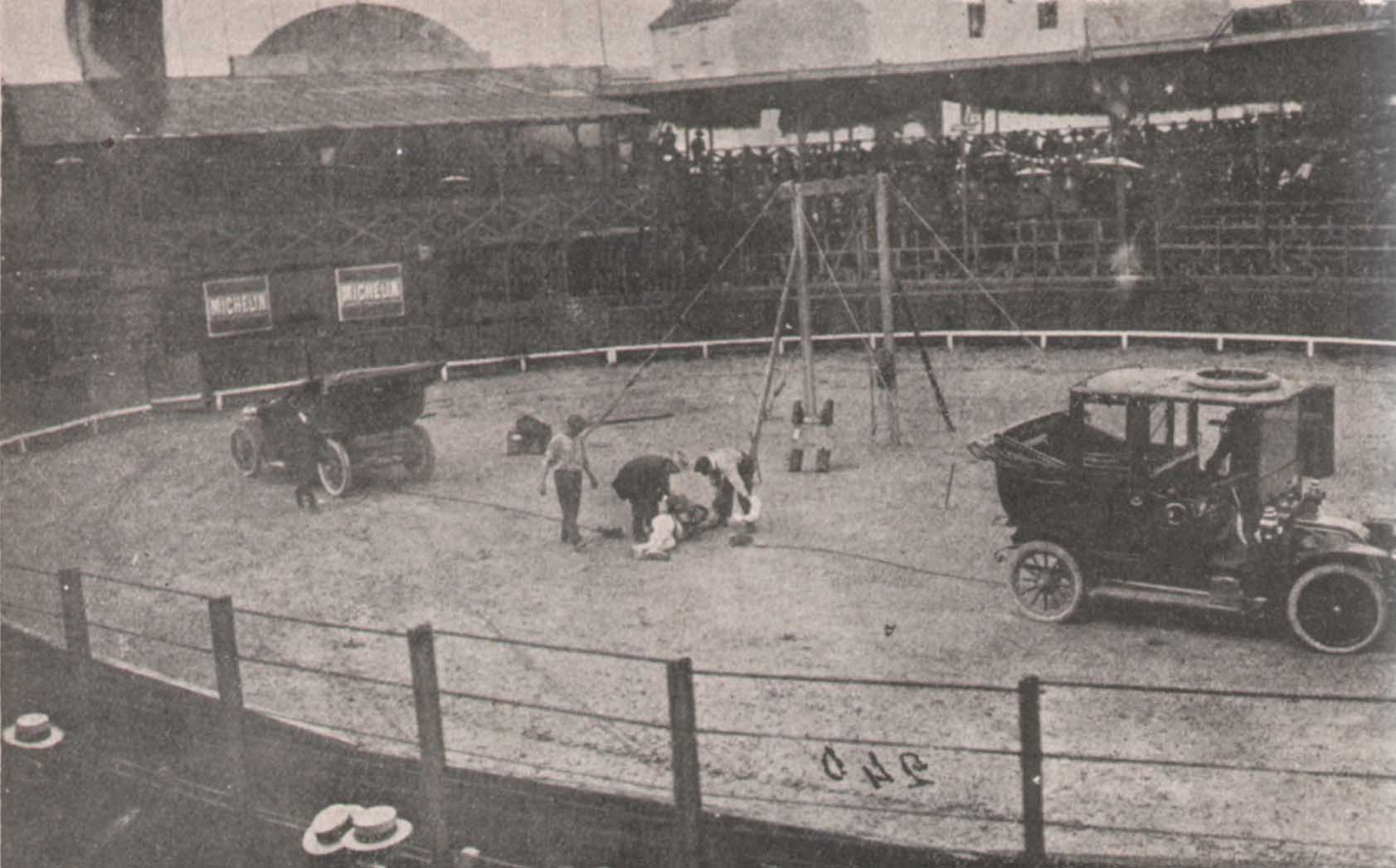
1923. An appeal for assistance, “the famous strongman desires employment as a right-hand man….”
p.168. ‘Qui Veut Employer Apollon’, La sante par les Sports, June, 1923.
p.22. ‘Apollon’, Translated and introduced by David Chapman, Iron Game History, August, 1997.
Had performed earlier as a strongman in the sentimental stage melodrama ‘La Loupiotte’ [The Kid].
p.22. ‘Apollon’, Translated and introduced by David Chapman, Iron Game History, August, 1997.
1924. He would play the title role in a new film called ‘Episodes of Roman Life under Tiberius’. It is unclear whether this film was ever produced.
p.223-224. ‘Apollon au Cinema’, by Dupont-Servoise, La sante par les Sports, August, 1924.
p.22. ‘Apollon’, Translated and introduced by David Chapman, Iron Game History, August, 1997.
1926. He was cast in the role of “Triton” (under the stage name Apollon Uni) in Rex Ingram’s ‘Mare Nostrum’.
p.22. ‘Apollon’, Translated and introduced by David Chapman, Iron Game History, August, 1997.
Photograph of Apollon in publicity still.
p.46. ‘Apollon, The Emperor of Athletes’ by Professor Edmond Desbonnet, Iron Game History, August, 1997.
Pictures taken at 66 years old. [1928]
p.144. Anvils, Horseshoes and Cannons, Volume 1 – Leo Gaudreau. 1975.
At 66 years of age he was still exhibiting his strength in travelling shows.
p.146. Anvils, Horseshoes and Cannons, Volume 1 – Leo Gaudreau. 1975.
Died October 18, 1928.
p.346. ‘Louis Uni dit Apollon n’est plus’, La Culture Physique, November, 1928.
p.22. ‘Apollon’, Translated and introduced by David Chapman, Iron Game History, August, 1997.
p.47. The Iron Game – David P. Webster. David Webster, Irvine, Scotland, 1976.
Obituary.
Le Populaire, Paris, October 20, 1928.
Please view this site for some excellent photos of Apollon. There are also other strongmen featured. On this page linked there are pictures of Apollon, including a post-mortem portrait, and if you click on the link street acts you will see pictures of him performing on stage and in the street. These pictures are priceless and wonderful.
For a picture and information on Apollon's 80kg Blockweight click here.
Books about Louis Uni 'Apollon'
DESBONNET (Edmund)
Apollon: Un Demi-Dieu de la Force [Apollon: a Demi-god of Strength].
pp. 55. Libraire Athletique: Paris, 1911.
Apollon-related photographs by Amaury Macaire
Louis Uni's Boulevard
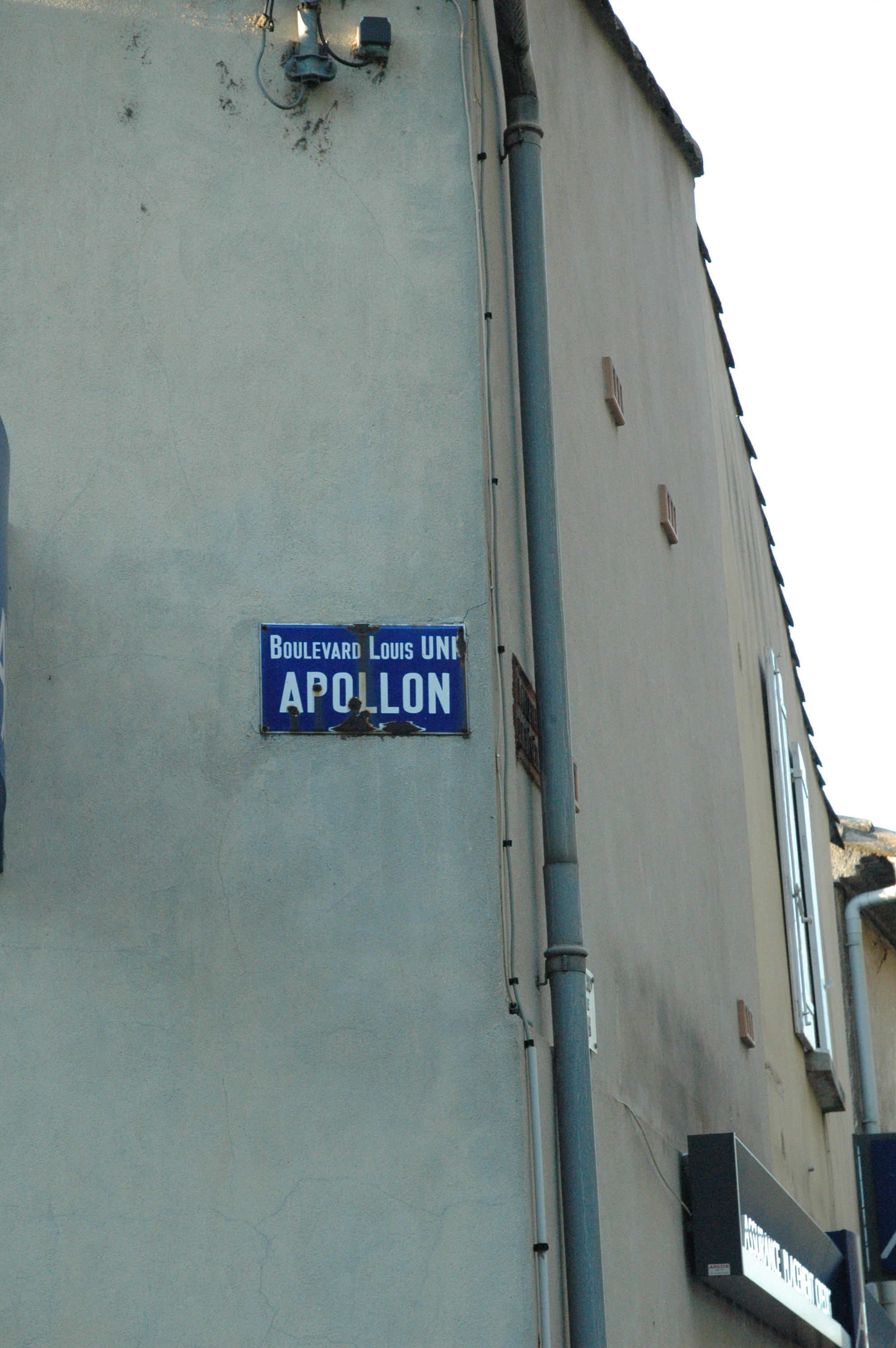

Louis Uni's house
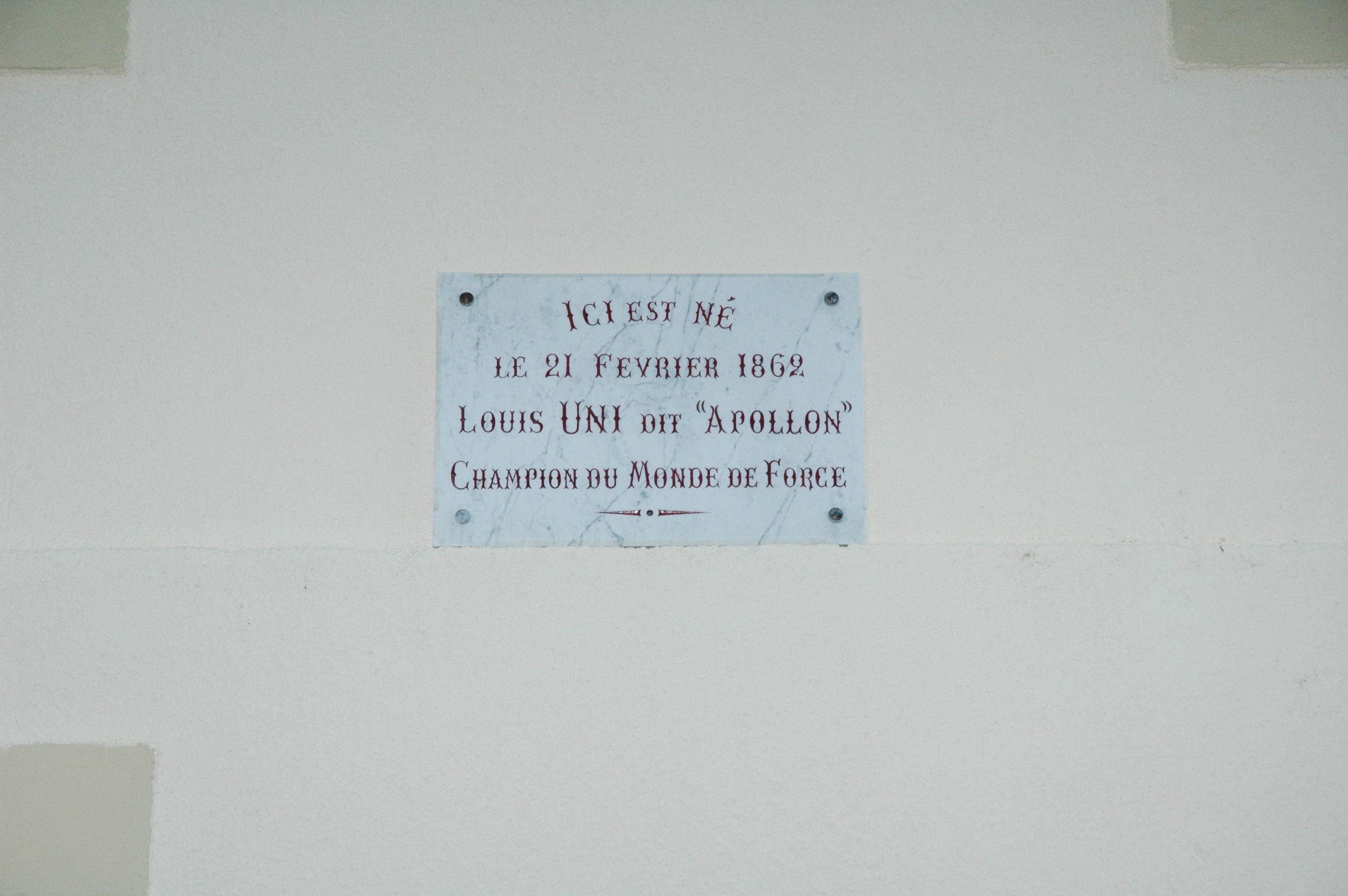

Copyright David Horne 2006

